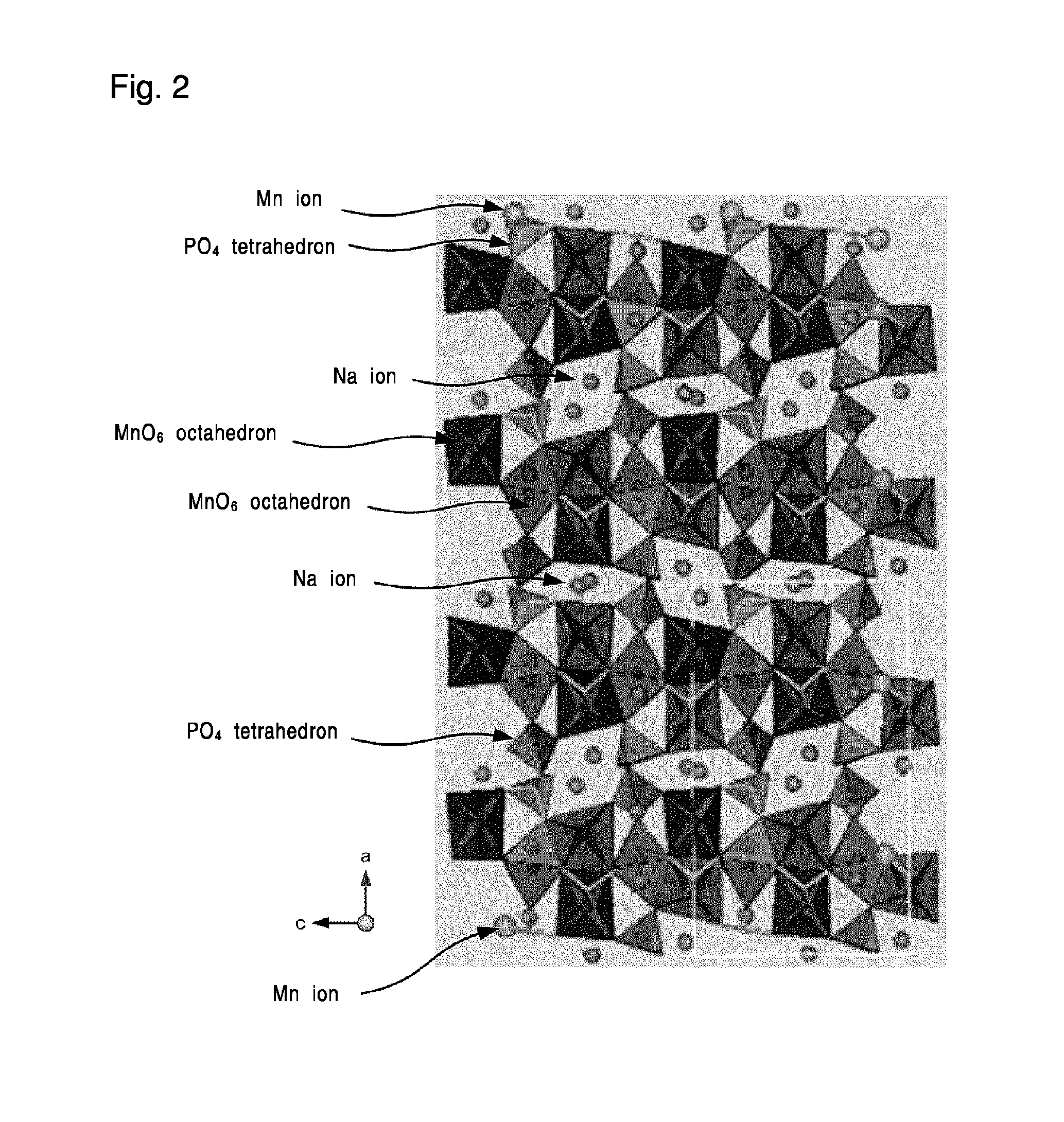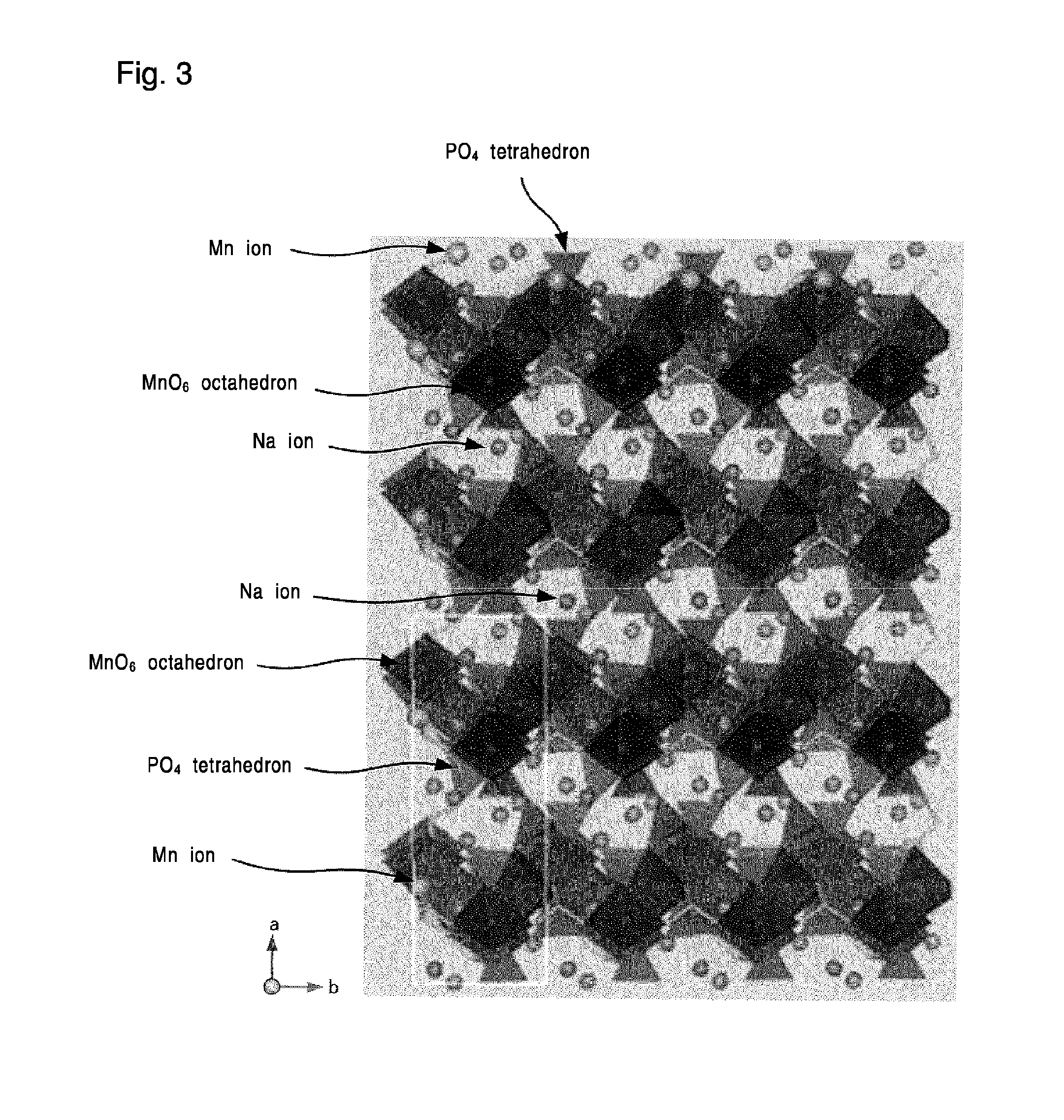Positive electrode material for sodium batteries and method for producing same
a sodium battery and positive electrode technology, applied in the direction of batteries, sustainable manufacturing/processing, cell components, etc., can solve the problems of increasing lithium prices, entering into mass production or expanding, etc., and achieve excellent electron conductivity and high operating potential
- Summary
- Abstract
- Description
- Claims
- Application Information
AI Technical Summary
Benefits of technology
Problems solved by technology
Method used
Image
Examples
example 1
Synthesis of Positive Electrode Material for Sodium Batteries
[0162]First, Na4P2O7 (Na-containing compound), (CH3COO)2Mn (Mn-containing compound) and NH4H2PO4 (P-containing compound) were mixed at a ratio of Na:Mn:P=4:3:4 (mol ratio). The mixture and glycolic acid (gelling agent) were dissolved in a nitric acid aqueous solution and stirred at 80° C. The resulting mixture was calcined under the air atmosphere at 700° C. for 15 hours, thus obtaining positive electrode active material particles.
[0163]The powder of the thus-obtained positive electrode active material particles and Ketjen black were mixed at a ratio of 5:1 (weight ratio). The mixture was kneaded by a planetary ball mill (zirconia ball) at 300 rpm for 24 hours to press and allow the electroconductive carbonaceous material to adhere to the surface of the positive electrode active material particles, thus preparing a complex.
[0164]The powder of the complex was heat-treated under an Ar atmosphere at 700° C. for 5 hours, thus ...
example 2
Synthesis of Positive Electrode Material for Sodium Batteries
[0179]First, Na4P2O7 (Na-containing compound), (CH3COO)2Co (Co-containing compound) and NH4H2PO4 (P-containing compound) were mixed at a ratio of Na:Co:P=4:3:4 (mol ratio). The mixture and glycolic acid (gelling agent) were dissolved in a nitric acid aqueous solution and stirred at 80° C. The resulting mixture was calcined under the air atmosphere at 700° C. for 15 hours, thus obtaining positive electrode active material particles.
[0180]The powder of the thus-obtained positive electrode active material particles and Ketjen black were mixed at a ratio of 5:1 (weight ratio). The mixture was kneaded by a planetary ball mill (zirconia ball) at 300 rpm for 24 hours to press and allow the electroconductive carbonaceous material to adhere to the surface of the positive electrode active material particles, thus preparing a complex.
[0181]The powder of the complex was heat-treated under an Ar atmosphere at 700° C. for 5 hours, thus ...
PUM
| Property | Measurement | Unit |
|---|---|---|
| temperature | aaaaa | aaaaa |
| electron conductivity | aaaaa | aaaaa |
| temperature | aaaaa | aaaaa |
Abstract
Description
Claims
Application Information
 Login to View More
Login to View More - R&D
- Intellectual Property
- Life Sciences
- Materials
- Tech Scout
- Unparalleled Data Quality
- Higher Quality Content
- 60% Fewer Hallucinations
Browse by: Latest US Patents, China's latest patents, Technical Efficacy Thesaurus, Application Domain, Technology Topic, Popular Technical Reports.
© 2025 PatSnap. All rights reserved.Legal|Privacy policy|Modern Slavery Act Transparency Statement|Sitemap|About US| Contact US: help@patsnap.com



